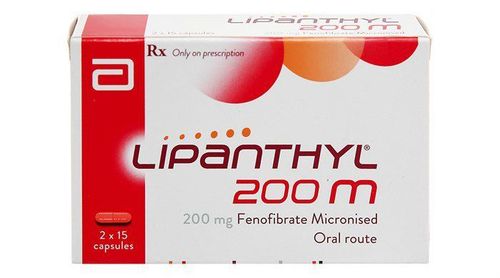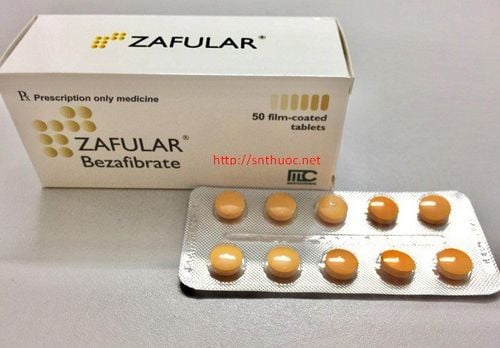This is an automatically translated article.
Lipistad is a film-coated tablet with atorvastatin as the main ingredient. This medication is used to treat patients with hyperlipidemia.1. Effects of Lipistad
Lipistad drug has the strength of Lipistad 10 and Lipistad 20. The effects of Lipistad 10 and 20 will be combined.
Lipistad drug belongs to the group of statin drugs, indicated in the following cases:
Reducing LDL - cholesterol, triglycerides and apolipoprotein B; increase HDL - cholesterol in the treatment of hyperlipidemia including hypercholesterolemia and mixed hyperlipidemia, hypertriglyceridemia and dysbetalipoproteinemia; Adjuvant therapy for patients with homozygous familial hypercholesterolaemia, with residual function of some LDL receptors. Lipistad is contraindicated in the following cases:
People with hypersensitivity to the active ingredients contained in the drug; Patients with active liver disease or unexplained persistent elevations in serum aminotransferase levels; Pregnant and lactating women.
2. How to take Lipistad
Some notes patients need to pay attention to about how to use Lipistad:
Lipistad is used orally, taken once a day, regardless of meals; Patients should have a standard, cholesterol-lowering diet before taking Lipistad and should maintain this diet during treatment with the drug; Lipistad should be started at the lowest effective dose, then the dose can be adjusted if necessary depending on the needs and response of the patient. The dose may be increased in increments of 4 weeks or more. It is necessary to closely monitor for adverse drug reactions, especially those on the muscle system.
3. Dosage of Lipistad
3.1 Usual Dosage: Adult starting dose of atorvastatin for the control of primary hypercholesterolemia and mixed dyslipidemia: 10 or 20 mg once daily. Patients who need to lower their LDL cholesterol - who need more than 45% to be effective should start with a dose of 40mg/day. The maintenance dose of atorvastatin in adults is 10 - 80 mg/time/day; Initial dose of atorvastatin for the treatment of heterozygous familial hypercholesterolaemia in boys 10 years of age and older and in postpubertal girls: 10 mg once daily. The maximum dose is 20mg/day; The usual dose of atorvastatin to control homozygous familial hypercholesterolemia: 10 - 80 mg once daily. It is also used as an adjunct to other lipid-lowering therapies or when these therapies are not available. Dosage of atorvastatin should be titrated at intervals of 4 weeks or more until desired lipoprotein concentrations are achieved. The dose of atorvastatin should be reduced in patients whose serum cholesterol levels fall below the required limit.
3.2 Dosage for special populations The dose of atorvastatin should be reduced in patients receiving drugs that interact with this drug as follows:
With amiodarone: Do not use atorvastatin more than 20mg/day; With ciclosporin: The maximum dose of atorvastatin is 10mg/time/day; With clarithromycin: The starting dose of atorvastatin is 10mg/time/day, the maximum dose is 20mg/time/day; With itraconazole: The starting dose of atorvastatin is 10m/time/day, the maximum dose is 40mg/time/day; With tipranavir + ritonavir, telaprevir: atorvastatin should be avoided; With lopinavir + ritonavir: Use atorvastatin cautiously with the lowest dose needed; With fosamprenavir + ritonavir, saquinavir + ritonavir, darunavir + ritonavir, fosamprenavir: Do not use atorvastatin more than 20mg/day; With nelfinavir: Do not take atorvastatin more than 40mg/day. Dosage in Renal Impairment: As atorvastatin is not significantly excreted by the kidneys, no dose adjustment is required in patients with renal impairment.
Dosage in patients with hepatic impairment: Because atorvastatin is metabolized primarily by the liver, there is the potential for accumulation in the plasma of patients with hepatic impairment, so caution should be used in patients with heavy alcohol consumption or a history of liver disease. . These patients should be closely monitored while taking atorvastatin.
The above Lipistad dosage is for reference only. The doctor can prescribe the appropriate dose for the patient depending on the condition and the progress of the disease.
3.3. Overdose There is no specific treatment for an overdose of Lipistad. In case of need, patients are treated symptomatically and supportive measures are applied.
3.4. Missed dose When a dose of Lipistad is forgotten, the patient should take it as soon as possible. If it is almost time for your next dose, skip the missed dose and take your next dose at the scheduled time.
4. Side effects of Lipistad
When using Lipistad, patients may experience some side effects such as:
Side effects are usually mild and transient such as: Constipation, flatulence, abdominal pain, indigestion; Side effects are not serious and reversible: Confusion, memory loss, increased HbA1c, increased blood sugar. When experiencing side effects of Lipistad, patients should stop taking the drug and notify their doctor or go to the nearest hospital for early treatment.
5. Be careful when using Lipistad
Before and while using Lipistad, patients should note:
Before taking the drug, patients should try to control hypercholesterolemia by adjusting their diet in a more scientific, collective way. education, weight loss for people who are obese, treatment of other diseases; Liver enzyme tests before starting statin therapy and in case your doctor orders it; Consider monitoring for creatinine kinase (CK): Before starting treatment, testing for CK is indicated in the following cases: Hypothyroidism, impaired renal function, history of hereditary myopathy, history of use-induced myopathy Previous fibrates or statins, history of liver disease, heavy drinking, elderly people (over 70 years old) at risk of rhabdomyolysis, drug interactions,... These cases need to be considered and monitored. during statin therapy. If CK test results are > 5 times the upper limit of normal, statin therapy should not be initiated; During statin treatment, patients should have a CK test when there are signs of muscle pain, stiffness or weakness; The risk of rhabdomyolysis is increased when atorvastatin is used in combination with drugs that increase plasma concentrations of atorvastatin (strong CYP3A4 inhibitors or carrier protein inhibitors); Atorvastatin should be temporarily or completely discontinued in patients with an acute and severe illness associated with myopathy or in patients with risk factors for progression to renal failure secondary to rhabdomyolysis (hypotension, major surgery, severe acute infections, trauma, severe endocrine and electrolyte disorders, metabolic disorders, epilepsy,...); The effectiveness and safety of atorvastatin has not been evaluated in children under 10 years of age or before puberty, so it is necessary to be cautious, consult a doctor before using Lipistad for children; Atorvastatin is contraindicated in pregnancy and lactation to avoid serious adverse effects on the fetus and nursing infant.
6. Lipistad drug interactions
Some of the drug interactions of Lipistad include:
Concomitant use of statins with gemfibrozil, high doses of niacin (> 1g/day), colchicine or other fibrate-lowering cholesterol drugs increases the risk of muscle damage; Avoid concomitant use of Lipistad with strong CYP3A4 inhibitors (ciclosporin, clarithromycin, itraconazole) and HIV protease inhibitors (ritonavir, lopinavir, darunavir). In case of co-administration of the above drugs, it is necessary to reduce the starting dose and the maximum dose of atorvastatin, the patient should be monitored clinically; Moderate CYP3A4 inhibitors (erythromycin, diltiazem, verapamil and fluconazole) may increase plasma concentrations of atorvastatin. The risk of myopathy is increased when erythromycin is used with statins. Consideration should be given to reducing the maximum dose of atorvastatin in combination with these agents, and the patient should be monitored clinically; Concom . Therefore, it is necessary to monitor patients clinically after starting or adjusting the dose of these drugs; Carrier protein inhibitors (ciclosporin) may increase the concentration of atorvastatin. If 2 drugs are used concurrently, it is necessary to reduce the dose of atorvastatin, monitor the clinical effect; Co-administration of colestipol with atorvastatin results in an approximately 25% decrease in atorvastatin plasma concentrations. However, if these two drugs are combined, they will have a higher effect on reducing LDL - C; When multiple doses of atorvastatin are administered with digoxin, steady-state plasma concentrations of digoxin are increased by approximately 20%. Therefore, it is necessary to monitor the health of patients taking digoxin; Concomitant administration of atorvastatin with oral contraceptives increases the AUC of norethindrone and ethinylestradiol; Grapefruit juice should not be taken concomitantly with atorvastatin to avoid the risk of side effects. Lipistad is well tolerated, and side effects are usually mild and transient. However, patients still need to be careful when taking the drug, follow all the instructions of the doctor. In particular, because the drug can interact with many other drugs, patients need to inform the doctor about the drugs they are using so that the dose and duration of medication can be adjusted accordingly.
Please dial HOTLINE for more information or register for an appointment HERE. Download MyVinmec app to make appointments faster and to manage your bookings easily.













